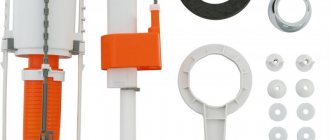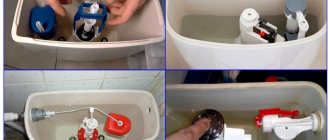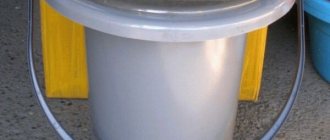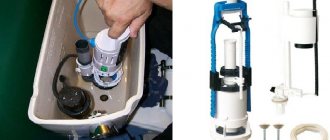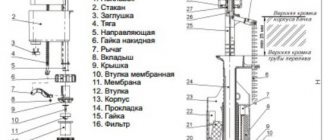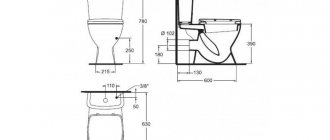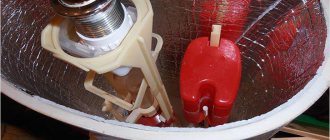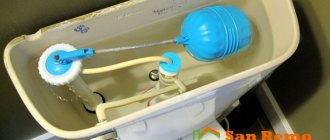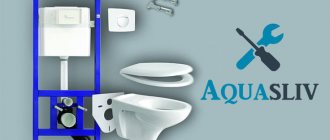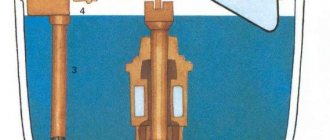SHARE ON SOCIAL NETWORKS
FacebookTwitterOkGoogle+PinterestVk
Properly selected and installed toilet fittings ensure uninterrupted functioning of the drainage system. The quality of plumbing fixtures largely depends on the design of the tank, its technological features, and fittings. Therefore, this article examines the main types of components for a toilet with side, top and bottom connections. In addition, the text provides recommendations for the selection and installation of various valve components.
The efficiency of the cistern depends not only on its technological features, but also on the correctly selected fittings
Common Problems
The occurrence of malfunctions in the toilet cistern is the most common malfunction in the functioning of the product. It is in this place that the main working mechanisms are located. Most often, toilet flush fittings suffer from increased frequency of use and technical flimsiness of the structure.
To properly troubleshoot the problem, it is important to understand how the mechanism works. That is why, before taking decisive action, they understand the design. Knowing the type of product will simplify the task.
Installing fittings yourself
Installation of fittings in the cistern is done in the following steps:
- At the bottom, the fastening nut is unscrewed from the trigger mechanism. Under it there is a rubber gasket, which is responsible for sealing the connection;
- an O-ring is mounted on the bottom of the drain tank;
- using a nut on the prepared gasket, the trigger mechanism is fixed;
- After this, you need to remove the fixing nut from the filling valve. In the case of fittings with side connections, the nut is located on the side of the valve, with the bottom connection respectively in the lower part;
- the sealing ring that needs to be installed on the hole from the inside of the tank is also located under the nut;
- An inlet valve is mounted inside the tank, which is secured with a plastic nut. During the first stage of installation, you need to slightly tighten the fixing nuts so that you can later correct installation defects;
- After installation, the exhaust and intake valves should not come into contact with the walls of the tank, or with each other. If such a defect exists, the elements must be rotated in different directions until the defect is eliminated. After installation is completed correctly, you need to tighten the fixing nuts as much as possible;
- A flexible hose is being installed to conduct water into the tank. When connecting this element, you also need to remember about the sealing gasket;
- checking the functionality of the fittings. If necessary, the float is adjusted. If using a float on a lever, it is necessary to bend the lever to the desired value. If the design uses a float, the movement of which is carried out along a guide, its stroke is limited by special clamps or a locking ring;
- installing the cover and connecting the drain button (handle). The maximum water level should not reach 4-5 cm to the edge of the tank.
During installation, you must strictly adhere to the steps described above and check the tightness of the resulting connections.
The essence of the cistern
Any toilet flush cistern is the most important working unit of the unit. The element provides water supply and sewage drainage. The part is a tank with holes for water inlet, outlet, and control levers. Inside the container there is fittings for the toilet cistern. This is a working mechanism.
The top of the tank is closed with a lid. The structure not only contains a functioning mechanism, but also serves as a storage facility for water. Externally, the part resembles an ergonomic tank connected to pipes and a sanitary bowl.
How are shut-off and drain valves adjusted?
If the tank and fittings set were purchased separately, the drain and shut-off valves require adjustment: the user determines the volume of water entering the container and the installation height of the drain valve.
Adjusting the Float Stop Valve
The products are available in two versions:
- with metal lever for float . To increase the volume of incoming water, it is bent so that the float is higher. To reduce the amount of liquid, do the opposite: bend the lever so that the float is lower;
- with plastic lever for float . This lever does not bend. The position of the float is adjusted with a special screw.
Usually inside the tank there is a mark for the optimal water level - you should follow it.
Sometimes it is not possible to adjust the filling level of the tank by moving the float; possible reasons:
- the shut-off valve is clogged . In this case, less water is supplied than the required volume. Having shut off the water supply to the apartment or on the branch to the tank, the valve is dismantled, disassembled and washed;
- The shut-off valve diaphragm is worn . Water flows continuously and flows through the overflow pipe into the toilet. Valve replacement required.
Adjusting the drain mechanism
It is necessary to install the bulb valve at the required height. The procedure depends on the design and is described in the manual.
When setting up a drain mechanism with a button, the button assembly is set so that it is located at a distance of 3-7 mm in relation to the lid. This ensures reliable fastening of the cover.
Then the flush button is screwed into the hole in the lid. To center the thread, first make a couple of turns counterclockwise and only then screw the element clockwise. No tools are required - just tighten by hand. The installation is completed by checking the drain mechanism.
When making adjustments, it is important to prevent the moving parts of the water filling valve and the drain mechanism from coming into contact. It is also necessary to ensure that none of the elements touch the wall of the tank.
Operating principle of the drain tank
The principle of operation of the drain tank is elementary. When the drain lever is pressed, water from the storage facility rushes down. At the same time, the outlet opens, which ensures that the reservoir is filled with fresh liquid.
The float is responsible for limiting the water supply. Moisture is collected only up to the set limit. After which the inlet hole is closed with a special valve. Simply put, there are 2 mechanisms inside the tank. One provides supply and control of water level, the other is responsible for removing moisture to the outside.
Side eyeliner
This is a classic option that can be found in any old apartment. Water is poured through a special hole on the side, and it is located above the water level.
In this case, the fittings are supplied directly to the water pipe, from where water flows. It has a push-button valve with a metal button.
You can learn more about the species in this video.
Types of cisterns
The presence of a cistern in the design is a prerequisite for the operation of the toilet. It is the closed container that ensures the installation of toilet fittings and guarantees the necessary aesthetics.
The operation of the system without the use of drain mechanisms is impossible. Supplying water directly from the pipeline will not do the job. In such a case, a jet of water will not be able to provide the required degree of cleansing of the bowl.
The drain tank is usually included in the kit, which is purchased under the guise of a plumbing product. There are different types of tanks.
Note!
- Design of a combined bathroom - the best solutions for creating ideal interiors with photo examples
Modern bathroom: design features and rules for designing a stylish bathroom (190 photo ideas)
- Bath design 2 sq. m. - design options and ideas for styling a small bathroom
How does the drain mechanism work?
Another important component of the toilet fittings is the mechanism responsible for the flush. The kit includes the following components:
- The drain hole is located at the bottom of the tanks. It must have the correct slope for smooth drainage of liquid from the drain tank.
- The overflow tube is an important mandatory component of the mechanism.
- Valve cover and elastic band that prevent spontaneous leakage of water downwards.
- A button responsible for opening the locking mechanism. Button control may involve one or two flush modes in the operation of the toilet, so the configuration will vary.
Any types of components for a home toilet must be made of high-quality durable materials. Cheap plastic can quickly fail under the influence of hardness salts, which are almost always present in tap water. In this case, the device will quickly stop working correctly and will require replacement.
According to the material of manufacture
Drain containers are divided into 3 types based on the material they are made of:
- Ceramic. The most common option. Sanitary ware is used for production. Such products are considered reliable and affordable classics.
- Metal. The option is economical and durable. The product has low aesthetic characteristics.
- Plastic. Cheap, simple, lightweight blocks. The disadvantage of this option is its fragility. The plastic tank is not solid enough.
You can find different examples on sale, but ceramic classics are the most popular.
Toilet tank: what's inside?
The toilet occupies a central place in any bathroom. If you can do without a shower or bathtub using a tray for ablutions, then the toilet is an indispensable device not only for every family member, but even for some pets.
Therefore, it is simply necessary to know its features and structure so that on a Saturday morning you do not find yourself face to face with such a breakdown.
You can repair or replace the tank fittings yourself. The main thing is to turn off the water before starting work and read the manufacturer’s recommendations for adjusting the structure
Features of cisterns
Toilet tanks differ in the material they are made of, the method of installation and connection to the water supply, and the type of button/lever location. And the price range of this type of plumbing fixtures is very wide - from inexpensive domestic models to exclusive design options from famous plumbing manufacturers.
Based on the material of manufacture, the following types of toilet cisterns are distinguished:
- earthenware;
- plastic;
- cast iron
The drainage fittings used for toilets are mainly made of plastic. This applies even to expensive models.
Only in exclusive versions do plumbers use metal fittings. Moreover, it is made of brass and bronze alloys
Earthenware cisterns have gained recognition and are most widespread throughout the world. It is this material that can most often be found in bathrooms where a pair of toilet + cistern is installed.
Earthenware products are produced by both domestic manufacturers and famous Western companies. Choosing the best option for your bathroom is not difficult.
Plastic models of drain tanks have a flattened shape. This is due to the specifics of their use - the so-called wall-hung toilets, when the flushing device is installed in the wall. The design is reliable, easy to maintain and has a long service life.
Plastic toilet tanks must have an inspection window after installation. It is usually located behind the flush button
Cast iron tanks are a relic of the past. Heavy, bulky and unpresentable designs are still used by many zealous residents of our country. But during renovations, old cast iron products are often replaced with beautiful modern plumbing fixtures.
Depending on the method of connection to the water supply, there are toilet tanks with upper and lower connections. The latter are more preferable - they look more presentable and create less noise during operation.
The option with top liner is produced by many Russian plumbing companies. To reduce noise when filling the container after draining, the fittings have been improved
There are three possible ways to install the cistern:
- top mount;
- installation in a false wall;
- on the toilet shelf.
The top mount is a retro option. This arrangement of the drainage device is used in retro-style bathrooms.
Retro-style toilet cisterns are very popular among owners of large bathrooms. In a modest bathroom such a product would be inappropriate, and its price is very high
The toilet installation is used for wall-hung models, when the tank is hidden in the wall. This allows you to save space in the bathroom and harmoniously fit the plumbing into the overall style of the bathroom/toilet room.
Cisterns built into the installation, hidden by a false wall, have a higher price compared to inexpensive domestic plumbing fixtures made of earthenware
Installation on the toilet shelf is a traditional solution. These are the usual models of a plumbing pair, when the drainage system is attached to the shelf of the toilet bowl.
Advantages: simplicity and affordability. And the choice is very wide - you can choose both a domestic version and elite plumbing fixtures from Italian, French or German manufacturers.
A flush cistern on the toilet shelf is the most convenient option to maintain. If there is a need for repairs, it is easy to get to the fittings
Internal structure of the tank
Inside each flush cistern there is a shut-off valve to control the operation of the toilet. For many models, the fittings come complete with all the necessary fasteners and nuts.
Based on the method of water supply and installation location in the tank, the following types of fittings are distinguished:
- top eyeliner;
- bottom eyeliner;
- universal.
The design with a top connection is built into the collection tank. A flexible water supply tube is connected from above. This must be taken into account, because such fittings are not suitable for every model of cistern. Basically, only domestic manufacturers provide top connections in their plumbing products.
Fittings with bottom connections are included with most Western-made waste cisterns. Moreover, the design is plastic, but the quality of all components is high.
When it is necessary to replace an individual part or the entire fittings with a lower water supply, it is better to buy a more expensive design from foreign companies. It will last longer (+)
The universal fittings for the toilet flush tank are convenient in that they can be placed in both a container with bottom and top water supply. If unnecessary, the second hole is fitted with a special plug included in the kit.
According to the type of material from which the reinforcement is made, there are:
- plastic structures;
- metal made of bronze or brass alloy.
Most models are equipped with plastic fittings. Moreover, if individual parts wear out, you can always purchase the necessary plumbing supplies at a plumbing store. If you don’t find what you need, you can buy a new design.
Metal fittings are more expensive than their plastic counterparts. It is made from corrosion-resistant alloys
The cistern fittings consist of 3 main components:
- filling;
- drain;
- overfill protection.
Filling is a unit that ensures that the container is filled with water supplied through a flexible pipe. The design of the fittings includes a special valve that blocks the access of water at the right time. Its operation is ensured by a float made of foam or other lightweight material.
Drain . The main part of this unit is the drain valve. It is activated by traction when the user presses a button/lever.
Overfill or overflow protection. The main element of this safety device for the drain tank fittings is a plastic tube, empty inside. It is installed vertically in the container.
The design of the fittings for the toilet flush tank is similar for all manufacturers. The difference is in the quality of plastic and, accordingly, the cost of the kit (+)
By mounting method, location
All tanks for draining water in the toilet are divided into 2 groups according to the method of fixation:
- Low located. The tank is installed directly on the toilet bowl. The product looks inseparable. This aesthetic appeals to most people. Modern models are made exactly in this form.
- Highly located. The tank is placed above the plumbing bowl. Can be hung on the wall or placed in a technical closet. The elements are attached to each other using a pipe. This option is considered a relic of the past.
When choosing a model, they pay attention not only to the convenience and aesthetics of the thing itself, but also to the possibility of creating the right interior.
How to make the right choice
Types of toilet flush
The general principle of flush operation for systems with a button is the same. The problem of choice arises when studying how to install waste tanks.
Located above the toilet at a height of at least 1 meter
This option is rare and is easy to repair; even an amateur can fix it. An undeniable advantage of high-mounted tanks is considered to be a powerful descent, which occurs due to the downward movement of water under the influence of gravity.
Cistern installed on the toilet
A common option. It fits easily into the toilet room, does not take up much space, and looks good. Attached to the bowl with a rubber cuff.
Hidden built-in tank
Most often it is installed during a major bathroom renovation. For installation, a plasterboard installation box with a depth of 10-15 cm is used, into which the tank is sewn. This design looks stylish and neat, because it gives the impression of a complete absence of a drainage device and only the toilet bowl is visible. Repairing and installing such a system will not be the easiest, but the result is worth it.
In addition to technical aspects, the choice is also influenced by preferences and material capabilities. If you plan to install a drain structure yourself, consider the complexity of the installation.
Operating procedure of the drain mechanism
The operation of the drain system is simple. After the water container is emptied, the float, which rests on the surface, moves down. This moves the valve, which closes the inlet. The opened entrance lets in a new portion of water. When the float reaches the set level, the shut-off valve for the toilet closes.
The system must have an overflow pipe. If for some reason the tank is overfilled beyond normal, the liquid flows into the sewer system, and not out over the edge of the tank.
The entire operation of the system is based solely on the laws of physics. Electronics are not involved in the operation of the mechanism. This greatly reduces the possibility of malfunction.
Design features of different types of shut-off valves
When deciding which fittings are best for a toilet cistern, you need to understand that, depending on the toilet model, a separate or combined design can be used.
Separate type equipment involves separate installation of the filler and drain valves and their autonomous operation. The water supply is regulated by a float, which closes the inlet when the tank is filled using a control rod. A unit consisting of a neck and an air or mechanical valve is responsible for draining the water.
For control, buttons, pedals, keys and levers are used. Separate shut-off valves have one undeniable advantage that should be taken into account when deciding which flush valve for a toilet is better. If a malfunction is detected, you can replace or repair only the damaged element, which allows you to save on the purchase of consumables, and also facilitates installation and dismantling of the entire assembly.
The combined design is used in new, more modern models and in toilets belonging to the elite class. Shut-off valves of this type involve connecting the drain and fill valves into one system, where they are in direct traction dependence. Adjustment of such a unit is more complex. However, having made preliminary precise settings, you can count on flawless operation of the entire unit. The main disadvantage of combined shut-off valves is the need for complete dismantling if damage or breakage is detected.
In addition, shut-off valves can be made of various materials. This is very important to understand when deciding what is the best fitting for a toilet. The bulk of such fittings is made of polymers; their composition has a huge impact on the strength, reliability and durability of each element and the entire system as a whole. It cannot be said that high-quality products will be very expensive, since competition among manufacturers of shut-off valves for toilets is quite high. However, it is worth noting that it is possible to identify counterfeits even among products from reliable manufacturers. Low quality products will make themselves known already at the first stage of operation.
Metal elements of shut-off valves are characterized by a long service life and high strength characteristics. For the manufacture of metal fittings, a special alloy of bronze or brass is used, which is not afraid of moisture and can withstand serious mechanical loads. Thanks to these properties, metal shut-off valves for toilets and plumbing fixtures function flawlessly for several years.
It is worth noting that combined metal fittings are installed only in elite-class plumbing equipment. As for the separate unit, almost all toilet models are equipped with them.
Common faults
The cost of replacing toilet fixtures is not that high. If problems arise, it is not difficult to find a technician who can easily understand the essence of the breakdown. The repair procedure will not take much time, effort or money.
Note!
- Bathroom accessories: tips for choosing and using stylish and simple accessories in the design | Interesting photo solutions
Bathroom furniture - real photos of typical interiors and examples of creative bathrooms
Bathroom 5 sq. m.: competent modern projects and features of their design in the current style
You can figure out the essence of the problem yourself. For example, questions often arise due to the water level in the tank. Just tighten the valve and the float will take the desired position.
If the levers fail, the float system will inevitably have to be replaced. If a malfunction occurs in the locking mechanism, you will not have to worry about the possibility of a flood. Water will flow through a special tube into the toilet bowl. This will lead to an increase in resource consumption on the meter, but will protect against liquid spills.
Types of float valves
There are several types of float valves.
- Croydon valve. It consists of a body, a float lever axis, a piston and a seat.
The float lever drives the piston. The piston movement in Croydon valves is vertical. This design is installed in old-style tanks. - Piston valve. In this design, the axis of the float lever is secured in a cotter pin, split in two.
By moving, the lever forces the piston to move in a horizontal direction. The piston, periodically in contact with the seat, regulates the flow of water into the tank.A gasket is mounted at the end of the piston, which blocks the water flow when the piston presses on the seat. Tanks with piston valves are found in many Russian apartments.
- Diaphragm valve .
In this type of design, a membrane (rubber or silicone) is installed instead of a piston gasket. The plastic piston, moving under the action of the lever, also moves the membrane. It blocks the water inlet. The diaphragm valve is the latest advancement in the production of cisterns.
In addition to plumbing, water can be used for additional heating of rooms. Recently, warm water floors have been gaining popularity, creating an optimal microclimate in the apartment. To learn how this can be organized, read the article Installing a water-heated floor. It’s not such an expensive pleasure, but the benefits of keeping your feet constantly warm are undeniable!
Summer water outages are not a problem if you have a water heater. One of the most popular companies in Russia is the Termex company, read about its water heaters with a capacity of 80 liters or more here, let your home always be comfortable.
Types of drain mechanisms
The toilet fittings are adjusted by a technician when installing the product. In most cases, no additional actions need to be performed. The operation of the mechanism has been adjusted by the manufacturer.
To activate the system, just press a button. It is the mechanical pressure on the lever that starts the flushing system. There are tanks with different types of trigger mechanisms (buttons, ropes, levers).
There may also be a difference in the order of drainage. The liquid may come out in a continuous stream. Horizontal descent is cheaper to implement, but does not clean the work area as well. The circular analogue is better in many performance characteristics.
The tanks themselves may be different. It's not even a matter of design or design features. Tanks differ in volume. Despite the typical operating principle, the details of the drain mechanism itself may also be different.
Usually a wide selection of fittings for the gustavsberg toilet is offered for sale. Spare parts are highly versatile and suitable for most modern sanitary products.
Basic repair methods
If the plumbing tank is initially equipped with high-quality fittings, it can last up to 20 years, but breakdowns often occur much earlier. However, many of them can be dealt with without much difficulty. Basic troubleshooting methods:
- If problems with the inlet membrane are caused by clogging with rust, scale or other large debris, the device component must be cleaned of contaminants. Installing a coarse filter before the water supply enters the tank will help completely solve the problem: it will trap large insoluble particles, and the toilet will last longer without failures.
- If the water does not drain when you press the flush button, you need to remove the cover and find the cause of the device malfunction. Button failure is usually associated with problems with plastic parts that will require replacement.
- If water does not fill the container quickly enough, it is necessary to adjust the position of the overflow tube. It should be located at least a centimeter below the button, the fittings must be placed in the correct position.
- If leaks appear at the threaded connections of toilet bowls, they can be eliminated by replacing the threaded gaskets. The connection is disassembled, new gaskets are installed, after which it is important to reassemble it correctly.
- If the pressure of the toilet flush has deteriorated, the cause is most often large particles of lime deposits and rust that have gotten into the hole. It must be cleaned of contaminants.
If you have never repaired toilets before or have never worked with plumbing, it is best to leave the task to a professional.
Leaks not only disrupt the comfort of using the fittings: they significantly increase water consumption, which means that utility bills increase. In addition, there is a risk of flooding your neighbors, after which you will also have to pay for someone else’s repairs. Toilet problems can be avoided if minor problems are corrected in a timely manner.
Dual mode tank
A modern tank with a couple of drain modes is popular. This option allows you to save water by using only part of the liquid according to your needs. To do this, a pair of buttons are installed on the tank.
Structurally, the design of such a mechanism is complicated. This carries the risk of increasing the possibility of breakdowns. Often the drain can be easily adjusted simply by applying force.
It is not difficult to ensure the smooth operation of the toilet flush system. It is enough to carefully approach the choice of device and monitor the accuracy of the mechanism. If necessary, it is easy to understand the essence of the problem and carry out the necessary repairs.
Tips for use
At this stage, when almost everyone pays for water after the fact, based on the meter readings, you can save a lot of money by correctly positioning the fittings in the drain tank. To do this, you just need to change the level at which the float stops when the tank is completely filled. Often this is achieved by slightly bending the lever on which the float is attached.
If during operation any part of the drain fittings fails, then you must take it with you as a sample when purchasing a new one. In most cases, there must be a complete match of spare parts for the design to function correctly.
When a float fails, the entire working unit must be replaced immediately. Since the length of the lever arm may vary. It is also necessary to completely replace all fittings of the drain tank, if they are imported.
Photo of toilet fittings
What's the result?
As you can see, in the design of a modern car, increased demands are placed on the engine cooling system and its correct operation. For this reason, for efficient operation, a special tank is additionally used in the design.
You also need to know that if the specified expansion tank of the engine cooling system is involved in the circuit, it is highly advisable to fill the system only with antifreeze or antifreeze, and not water
As for breakdowns, if pressure increases in the cooling system or air pockets form, special attention must be paid to the expansion tank cap. Malfunction of the valves in the cap often leads to damage to the pipes, the thermostat fails faster, and the cooling system pump suffers. ), the engine may overheat, etc.
Malfunction of the valves in the cover often leads to damaged pipes, the thermostat fails faster, the cooling system pump (pump) suffers, the engine may overheat, etc.
